No products in the cart.
Understanding Carpal Tunnel Syndrome: Your Comprehensive Guide
Welcome to our in-depth FAQ article, designed specifically for those who think they might be suffering from carpal tunnel syndrome. Living with the symptoms of carpal tunnel syndrome can be incredibly frustrating, affecting your daily activities and overall quality of life. But don’t worry—we’re here to help!
In the sections below, we’ll delve into everything you need to know about carpal tunnel syndrome. We’ll start by explaining what exactly carpal tunnel syndrome is and how it occurs. Next, we’ll explore the common causes and risk factors that can lead to the development of this condition. We’ll also guide you through identifying the telltale signs and symptoms so you can better understand if you might have carpal tunnel syndrome.
But that’s not all. We know that finding effective treatment is crucial for managing and overcoming carpal tunnel syndrome. That’s why we’ll highlight some of the most successful treatments available, including valuable products that you can purchase from NuovaHealth to ensure a speedy and effective recovery.
Whatever questions you have about carpal tunnel syndrome, we’ve got you covered. Let’s get started on the path to relief and better health!
Introduction to Carpal Tunnel Syndrome
What exactly is carpal tunnel syndrome?
Carpal tunnel syndrome is a medical condition resulting from the compression of the median nerve. This nerve runs through a narrow passageway in the wrist called the carpal tunnel. When the median nerve is compressed, it can lead to symptoms like pain, numbness, and tingling in the hand and fingers. This condition often affects the thumb, index, and middle fingers, causing considerable discomfort.
How does carpal tunnel syndrome occur?
Carpal tunnel syndrome occurs when the tissues surrounding the flexor tendons in the wrist swell and press on the median nerve. Factors contributing to this swelling include repetitive hand movements, wrist injuries, and underlying health conditions like diabetes or rheumatoid arthritis. In essence, anything that causes inflammation or fluid retention in the wrist can lead to this syndrome.
What part of the body is affected by carpal tunnel syndrome?
Carpal tunnel syndrome primarily affects the following areas:
- Median Nerve: This is the main nerve affected by carpal tunnel syndrome. It runs from the forearm into the palm and provides sensation to the thumb, index finger, middle finger, and part of the ring finger.
- Carpal Tunnel: A narrow, rigid passageway of ligament and bones located at the base of the hand. The median nerve and several tendons run through this tunnel.
- Thenar Muscles: These are the muscles located at the base of the thumb. Compression of the median nerve in the carpal tunnel can lead to weakness or atrophy in these muscles, affecting thumb movement.
- Flexor Tendons: These are the tendons that help in bending the fingers. They also pass through the carpal tunnel alongside the median nerve and can become irritated and inflamed, contributing to symptoms.
- Palmar: The palm side of the hand where the median nerve provides sensory feedback. This area can experience numbness, tingling, and pain due to carpal tunnel syndrome.
- Thumb: Often experiences weakness and difficulty with gripping or pinching motions due to the impact on the thenar muscles and median nerve.
- Index and Middle Fingers: These fingers can experience numbness and tingling, as they are primarily served by the median nerve.
- Ring Finger: The median nerve affects the thumb side of the ring finger, leading to partial numbness or tingling in this area as well.
Understanding the specific areas affected by carpal tunnel syndrome can help in diagnosing and treating the condition effectively.
Is carpal tunnel syndrome a common condition?
Yes, carpal tunnel syndrome is relatively common. According to research published by the National Health Service (NHS) in the UK, approximately 3-6% of adults experience this condition at some point in their lives. It’s particularly prevalent among individuals who perform repetitive tasks with their hands, such as typing or assembly line work.
Who is most likely to develop carpal tunnel syndrome?
Certain groups of people are more prone to developing carpal tunnel syndrome. These include individuals who engage in repetitive hand movements, such as typists, musicians, and assembly line workers. Additionally, women are three times more likely than men to develop this condition, possibly due to anatomical differences. Other risk factors include age (most common in people aged 40-60), pregnancy (due to fluid retention), and medical conditions like diabetes and rheumatoid arthritis.
Understanding carpal tunnel syndrome is crucial for managing and preventing it effectively. If you suspect you have this condition, consulting a healthcare professional is the first step toward relief.
Causes and Risk Factors
What are the primary causes of carpal tunnel syndrome?
Carpal tunnel syndrome often develops from pressure on the median nerve. This pressure can be caused by a variety of factors, but it commonly results from swelling or inflammation. These causes are multifaceted, complex, and demand careful management.
Inflammatory Conditions
One of the primary contributors to median nerve compression is inflammation. Conditions such as rheumatoid arthritis, a chronic inflammatory disorder, are significant culprits. Rheumatoid arthritis causes the synovium (the lining of membranes surrounding joints) to swell, leading to increased pressure within the carpal tunnel. The resultant inflammation and tissue hypertrophy (thickening) exacerbate the compression of the median nerve.
Hormonal Influences
Hormonal changes, particularly in women, also play a pivotal role in the onset of carpal tunnel syndrome. During pregnancy, the body undergoes substantial hormonal fluctuations, which can lead to fluid retention. This fluid retention increases pressure within the carpal tunnel, thereby heightening the risk. Moreover, menopause can alter hormone levels, further predisposing women to this syndrome.
Occupational Factors
Repetitive wrist movements, common in professions involving extensive typing or assembly line work, often contribute to the development of carpal tunnel syndrome. Repetitive actions can lead to tenosynovitis (inflammation of the tendon sheath), which narrows the carpal tunnel space and puts pressure on the median nerve. Ergonomic risks, such as improper hand positioning and inadequate breaks, further exacerbate this issue.
Genetic Predisposition
Genetic factors cannot be overlooked when considering the etiology (cause) of carpal tunnel syndrome. Individuals with a family history of the condition are at a higher risk. Genetic predisposition may influence the anatomical structure of the carpal tunnel, making it naturally narrower in some individuals, hence more susceptible to nerve compression.
Systemic Conditions
Systemic conditions like diabetes mellitus significantly impact the likelihood of developing carpal tunnel syndrome. Elevated blood sugar levels associated with diabetes can lead to diabetic neuropathy (nerve damage), which exacerbates the susceptibility of the median nerve to compression. Similarly, hypothyroidism (underactive thyroid) can lead to mucopolysaccharide (a type of carbohydrate) deposition in the tissues surrounding the median nerve, increasing the pressure within the carpal tunnel.
Are there genetic factors involved in carpal tunnel syndrome?
Yes, genetics can play a role. If your parents or siblings have carpal tunnel syndrome, you may be more likely to develop it, too. Studies suggest that genetic predisposition could influence the structure of your wrist or the response to inflammatory conditions, which can contribute to the development of carpal tunnel syndrome. It’s worth discussing your family medical history with your doctor.
How does repetitive hand motion contribute to carpal tunnel syndrome?
Repetitive hand motions—those that involve prolonged or forceful use of the wrist—can exacerbate carpal tunnel syndrome. Typing, assembly line work, and other tasks that require repetitive wrist movements can lead to swelling and pressure on the median nerve. This repetitive strain can lead to chronic irritation, and over time, symptoms like tingling and numbness can develop.
Can carpal tunnel syndrome be caused by an injury?
Absolutely. Wrist injuries can lead to carpal tunnel syndrome. A fracture, sprain, or any trauma to the wrist can cause swelling or structural changes. This, in turn, can squeeze the median nerve. Even after the wrist heals, some individuals may continue to experience symptoms due to permanent changes in the wrist’s interior structure.
Does computer use increase the risk of developing carpal tunnel syndrome?
This is a common concern. While prolonged computer use, particularly extensive typing or mouse use, can contribute to the development of carpal tunnel syndrome, it’s not the sole cause. It’s the repetitive motions and poor ergonomics that play a more significant role. Ensuring proper wrist posture and taking regular breaks can help mitigate this risk. However, other factors like genetics and underlying health conditions also matter.
Carpal tunnel syndrome can be daunting, but understanding its causes and risk factors empowers you to manage it better. Always consult a healthcare provider to determine the best course of action for your specific situation.
Symptoms and Diagnosis
What are the early signs of carpal tunnel syndrome?
Carpal tunnel syndrome starts subtly. You may notice tingling or numbness in your thumb, index finger, or middle finger. Often, these sensations occur during the night, leading to disturbed sleep. Weakness in the hand and a tendency to drop objects are also early signs. If you experience these symptoms consistently, it’s crucial to seek medical advice.
How does carpal tunnel syndrome affect overall hand function?
Carpal tunnel syndrome significantly impacts overall hand function. The syndrome can impair your ability to perform everyday tasks, such as gripping objects or typing. You might experience a tingling sensation, numbness, or even a burning pain. This can compromise manual dexterity (skill in performing tasks, especially with the hands) and weaken grip strength. The consequences? A daily struggle with common activities.
How can you differentiate between carpal tunnel syndrome and other hand/wrist conditions?
Distinguishing carpal tunnel syndrome from other conditions like arthritis or tendonitis can be challenging. However, specific symptoms can serve as clues. Carpal tunnel syndrome often causes numbness and tingling in the thumb, index, and middle fingers. In contrast, arthritis might cause swelling and pain in different joints. Tendonitis usually results in pain and tenderness along the tendons rather than numbness. Consulting a healthcare professional is essential for an accurate diagnosis.
Which healthcare professionals can diagnose carpal tunnel syndrome?
Various healthcare professionals can diagnose carpal tunnel syndrome. You might start with your general practitioner, who can refer you to a specialist if necessary. Orthopedic surgeons, neurologists, and rheumatologists are experts often involved in diagnosing and treating this condition. Occupational therapists can also provide valuable insights and management strategies.
What diagnostic tests are used to confirm carpal tunnel syndrome?
To confirm carpal tunnel syndrome, healthcare providers use several diagnostic tests. A physical examination is the first step, where the doctor checks for signs like swelling, tenderness, and weakness in the hand. Nerve conduction studies (tests measuring the speed of electrical impulses through the nerves) and electromyography (a test recording the electrical activity of muscles) are commonly used. These tests help determine the severity of the condition and rule out other issues.
Can carpal tunnel syndrome symptoms vary in intensity?
Yes, the intensity of carpal tunnel syndrome symptoms can fluctuate. For some, symptoms are mild and infrequent. Others may experience severe and persistent discomfort, impacting daily activities. Factors such as repetitive hand movements, wrist positioning, and overall health can influence symptom severity. Managing the condition early can prevent it from worsening.
Can carpal tunnel syndrome lead to permanent damage if left untreated?
Indeed, carpal tunnel syndrome can lead to permanent damage if left untreated. The median nerve (the main nerve running through the wrist) can suffer ongoing compression. This chronic pressure can cause irreversible damage, leading to persistent numbness, weakness, and muscle atrophy (wasting away). It’s crucial to address symptoms early. Don’t ignore them—your health is at stake.
By understanding these different aspects of carpal tunnel syndrome, you are better equipped to identify and address potential carpal tunnel syndrome symptoms. Don’t hesitate to consult a healthcare professional if you have concerns. Early intervention can make a significant difference!
Treatments and Prevention
General Treatments
What are the initial treatments for carpal tunnel syndrome?
Initial treatments for carpal tunnel syndrome focus on alleviating pain and reducing inflammation. Resting the affected hand and wrist is key. Immobilizing the wrist in a splint (a device to hold the wrist in a neutral position) during the night can prevent further damage. Ice packs applied to the wrist can also reduce swelling and numb the pain. Additionally, nonsteroidal anti-inflammatory drugs (NSAIDs) like ibuprofen may provide relief.
How effective is physical therapy for carpal tunnel syndrome?
Physical therapy can be really effective for carpal tunnel syndrome, particularly in its early stages. Techniques such as nerve gliding exercises (movements designed to stretch and mobilize the median nerve) can help reduce symptoms. A physical therapist may also recommend ultrasound therapy (using sound waves to reduce inflammation) or manual therapy (hands-on techniques to improve mobility). These methods aim to restore function and alleviate discomfort, though the success varies from person to person.
What medications are typically prescribed for carpal tunnel syndrome?
Medications for carpal tunnel syndrome often include oral corticosteroids to reduce inflammation. Sometimes, corticosteroid injections directly into the carpal tunnel offer immediate relief. For milder pain, over-the-counter NSAIDs like ibuprofen or naproxen can help.
Consult a healthcare provider to determine the best medication based on the severity of your condition. Always talk to your doctor before starting any new medication, especially if you have an underlying health condition. Your doctor will review your medical history, current medications, and overall health to ensure safety and suitability. This step is crucial to avoid potential drug interactions, side effects, or worsening of existing issues.
Always get your medication from reputable sources, such as your local pharmacy. Never buy medication online, as it may be counterfeit, contaminated, or expired. Such medications can carry incorrect dosages or harmful ingredients, leading to serious health risks, including adverse reactions, ineffective treatment, and even death.
How can surgical options help in severe cases of carpal tunnel syndrome?
In severe cases where non-surgical treatments fail, surgery may be necessary. Carpal tunnel release surgery aims to relieve pressure on the median nerve by cutting the transverse carpal ligament (a band of tissue that compresses the nerve). This can be done through open surgery (a larger incision) or endoscopic surgery (using a small camera). The success rate is high, with many patients experiencing significant symptom relief and improved hand function post-operation. However, recovery times and outcomes can vary.
Prevention Strategies
What are some effective strategies to prevent carpal tunnel syndrome?
Adopting healthier habits and practices is key to preventing carpal tunnel syndrome. Regular breaks from repetitive tasks can reduce wrist strain. Keeping the wrist in a neutral position (straight, not bent) during activities also helps. Maintaining a balanced diet and regular exercise supports overall hand health, further reducing the risk of developing carpal tunnel syndrome.
How can ergonomic adjustments in the workplace help prevent carpal tunnel syndrome?
Making ergonomic adjustments in the workplace is crucial for preventing carpal tunnel syndrome. Proper workstation alignment reduces wrist strain. Ergonomic keyboards and mouse devices promote a neutral wrist position. Additionally, ensuring your chair and desk height encourage good posture can further minimize risk. These changes create a more comfortable work environment, reducing the likelihood of carpal tunnel syndrome.
What exercises can help in preventing carpal tunnel syndrome?
Certain exercises can help prevent carpal tunnel syndrome by strengthening and stretching the muscles and tendons in the hand and wrist. Wrist flexor and extensor stretches (bending the wrist forward and backward) enhance flexibility. Nerve gliding exercises mobilize the median nerve. Regularly performing these exercises maintains wrist health and prevents the onset of symptoms.
How does maintaining overall hand health contribute to preventing carpal tunnel syndrome?
Maintaining overall hand health plays a significant role in preventing carpal tunnel syndrome. Regularly stretching and strengthening the hands and wrists keeps the muscles and tendons flexible and robust. Proper hydration and a balanced diet support tissue health. Avoiding overuse and giving your hands adequate rest can prevent strain and injury. By prioritizing hand health, you can reduce the risk of developing carpal tunnel syndrome and maintain optimal function.
Compression Therapy Products from NuovaHealth
How Does Compression Therapy Work for Carpal Tunnel Syndrome?
Compression therapy works by applying consistent pressure to the affected area. This pressure helps to reduce swelling, improve blood circulation, and support muscle and joint stability. For carpal tunnel syndrome, compression therapy can decrease inflammation and provide immediate relief from pain and discomfort. Enhanced blood flow facilitates quicker healing and reduces the likelihood of recurrent symptoms.
How Can Wrist Braces Help with Carpal Tunnel Syndrome?
Wrist braces provide structural support to the wrist, helping to keep it in a neutral position. This alleviates pressure on the median nerve (the nerve running through the carpal tunnel) and reduces the inflammation and pain associated with carpal tunnel syndrome. By stabilizing the wrist, these braces prevent harmful wrist movements that can exacerbate symptoms, providing a pathway to relief.
What Should I Look for When Choosing a Wrist Brace for Carpal Tunnel Syndrome?
When selecting a wrist brace, consider comfort, support, and material. Look for a brace that is adjustable and made of breathable fabric to ensure comfort during extended use. Support is crucial—choose a brace that keeps your wrist in a neutral position without restricting blood flow. Materials should be durable yet gentle on the skin to prevent irritation. NuovaHealth’s wrist braces combine all these features for optimal support and comfort.
Are There Specific Features in NuovaHealth’s Wrist Braces That Make Them Effective?
Absolutely! NuovaHealth’s wrist braces are designed with the user in mind, offering adjustable straps for custom fit, breathable materials for all-day comfort, and sturdy supports that maintain wrist alignment. These features ensure that our braces provide both immediate relief and long-term support.
Are There Specific Wrist Braces Designed for Nighttime Use?
Indeed, there are wrist braces specifically designed for nighttime use. These braces typically offer more robust support and cushioning to keep the wrist in a neutral position throughout the night, preventing any unconscious movements that could exacerbate symptoms.
How Should I Clean and Maintain My NuovaHealth Wrist Brace?
Keeping your wrist brace clean is simple. Hand-wash it with mild soap and warm water, then let it air dry. Regular cleaning ensures hygiene and longevity. Avoid using harsh chemicals or machine washing, as these can degrade the materials.
How Long Does It Usually Take to See Improvement with the Use of a Wrist Brace?
Improvement timelines can vary. Many users report feeling relief within a few days of consistent use, while others may take a few weeks. The key is to use the brace as recommended and combine it with other treatments like stretching exercises. Patience is vital; gradual improvement is common and should be encouraging.
What Are the Benefits of Using Compression Gloves for Carpal Tunnel Syndrome?
Compression gloves offer several benefits. They provide gentle compression that helps reduce swelling and discomfort in the wrists and hands. The warmth generated by the gloves also soothes aching muscles and joints, promoting better hand function. An added benefit is the improved circulation, which aids in the healing process and reduces stiffness.
Can I Use Compression Gloves While Sleeping to Alleviate Carpal Tunnel Symptoms?
Yes, you can! Wearing compression gloves while sleeping can be highly effective. They maintain consistent pressure and warmth, reducing inflammation and pain that can disrupt your sleep. Ensure the gloves are comfortable and not too tight to prevent circulation issues.
What Makes NuovaHealth’s Compression Gloves Unique Compared to Other Brands?
NuovaHealth’s compression gloves stand out due to their ergonomic design, high-quality materials, and targeted compression zones. Our gloves are crafted to provide maximum comfort and effectiveness, with meticulous attention to detail, ensuring they meet the highest standards.
Are There Any Side Effects of Using Wrist Braces or Compression Gloves?
Generally, wrist braces and compression gloves are safe to use. However, overuse or improper fitting can cause skin irritation, numbness, or restricted blood flow. It’s important to monitor your symptoms and adjust the fit as needed. If you experience severe discomfort, consult a healthcare professional.
How Often Should I Wear a Wrist Brace or Compression Gloves for Effective Treatment?
Consistency is key. Wearing your wrist brace or compression gloves during activities that strain your wrists, such as typing or lifting, is essential. It’s also advisable to wear them during the night if your symptoms are severe. However, balance is important—overuse can lead to dependency. Aim to wear them for several hours daily, adjusting based on your comfort and symptom severity.
Can Children Use Wrist Braces and Compression Gloves for Carpal Tunnel Syndrome?
Yes, children can use wrist braces and compression gloves, but it’s essential to choose products specifically designed for their smaller hands and wrists. Consult with a healthcare professional to ensure the proper fit and suitability.
What customer support options does NuovaHealth provide for their products?
At NuovaHealth, we are dedicated to providing excellent customer service. Our products are available exclusively on our website, ensuring you’re getting authentic NuovaHealth quality every time. If you need assistance, we offer multiple support channels. You can reach out via phone for direct conversations with our trained representatives. Email support is available for detailed inquiries. Additionally, a comprehensive FAQ section on our blog addresses common questions and concerns. Seeking help should never be a hassle—NuovaHealth aims to make it straightforward and stress-free.
Are there any testimonials or reviews available from customers who have used NuovaHealth products for carpal tunnel syndrome?
Yes, many customers have shared their experiences with NuovaHealth products. These testimonials highlight the effectiveness and comfort of our wrist braces and compression gloves. Users often mention relief from pain, increased mobility, and overall satisfaction. Reading these reviews can offer valuable insights and reassurance. Real experiences from real people—nothing is more convincing than authentic feedback.
Does NuovaHealth offer any guarantees or return policies on their wrist braces and compression gloves?
Absolutely, at NuovaHealth, we stand behind the quality of our products. We provide a satisfaction guarantee, ensuring you get the support and relief you need. If you’re not happy with your purchase, our return policy is straightforward. You can return the items within a specified period for a refund or exchange. Customer satisfaction is our top priority—your peace of mind matters.
How can I purchase NuovaHealth products for carpal tunnel syndrome?
Purchasing NuovaHealth products for carpal tunnel syndrome is simple and convenient. Our items are exclusively available through our website, ensuring a secure and seamless checkout process with PayPal or Stripe. We prioritize quick delivery, with all items dispatched first class using Royal Mail. Take control of your comfort—buying the right support has never been easier or faster.
NuovaHealth cares about your journey with carpal tunnel syndrome. Our commitment to quality, coupled with robust customer support, ensures you get the best possible experience. Stay informed, stay supported, and take proactive steps towards your well-being.
Discover Our Top Picks: Best Hand & Wrist Braces for Carpal Tunnel Syndrome
At NuovaHealth, we are committed to providing you with the best solutions for managing carpal tunnel syndrome. Our expertly designed braces are crafted from medical-grade materials, ensuring both comfort and effectiveness. Plus, each brace comes with a full 30-day money-back guarantee. Check out our top recommendations and find the perfect brace to support your hand and wrist health today.
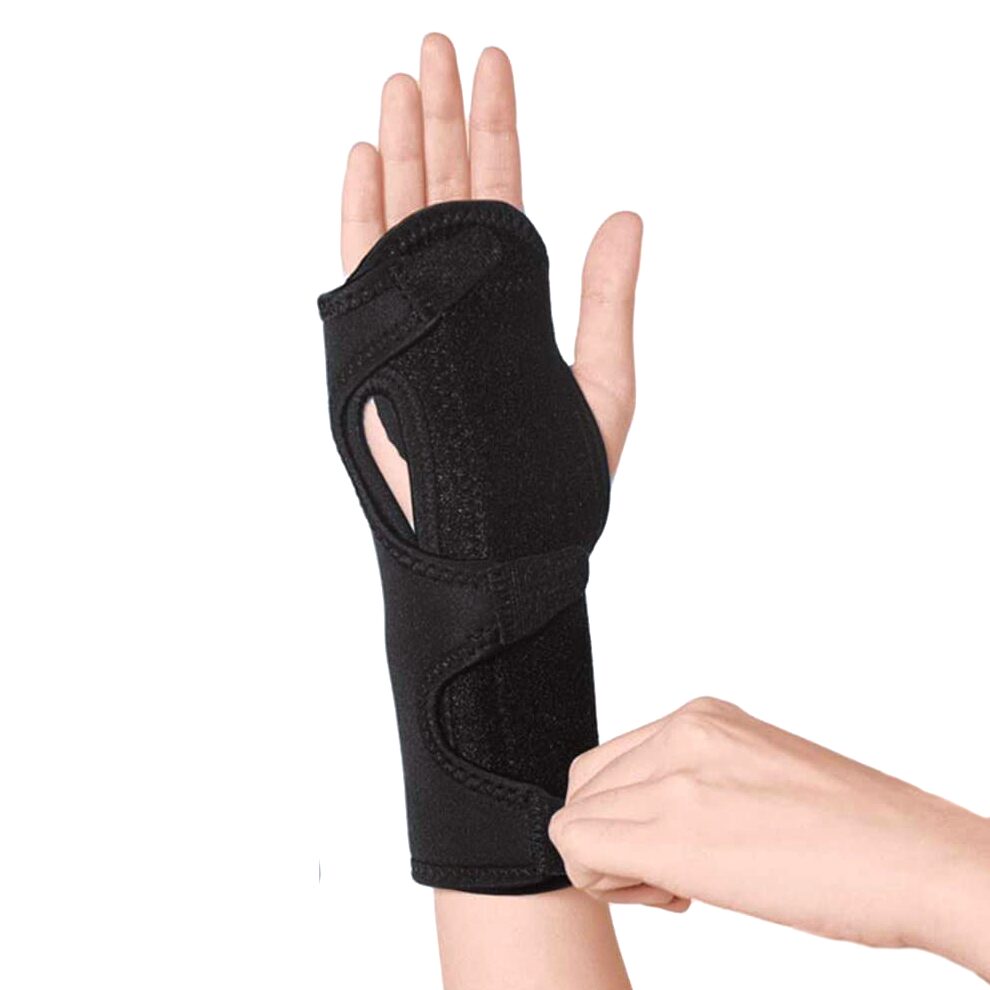
Carpal Tunnel Syndrome Splint
If you’re struggling with carpal tunnel syndrome, you’re likely searching for a solution to alleviate pain and speed up recovery. Look no further than our highly recommended Carpal Tunnel Syndrome splint. This brace not only provides significant relief from carpal tunnel symptoms but also supports the healing of various other wrist conditions such as repetitive strain injuries, wrist fractures, sprains, tendonitis, and arthritis.
One of the standout features of this splint is its advanced orthopaedic technology, designed to support, compress, and protect your wrist. It’s engineered to accelerate recovery, making it an excellent choice for anyone dealing with wrist injuries. The brace includes a removable aluminum splint that immobilizes your hand and wrist, ensuring that your bones, ligaments, and tendons remain stable. This immobilization aids the healing process and minimizes the risk of further injury.
Additionally, the splint boasts a bed of cushioning beads that cradle your palm in a neutral, comfortable position. These beads provide customized support, easing pain and preventing muscle cramps and spasms. They also act as a buffer against shock and pressure, protecting your injured hand from additional harm.
Crafted from soft, padded materials, this splint features breathable ventilation holes and moisture-wicking technology to keep your wrist cool and dry. Its anti-odor properties ensure that you can wear it for extended periods without discomfort, making it ideal for overnight use. Say goodbye to restless nights and hello to a pain-free, restful sleep.
Invest in this Carpal Tunnel Syndrome splint today, and take a significant step towards a quicker, more comfortable recovery.
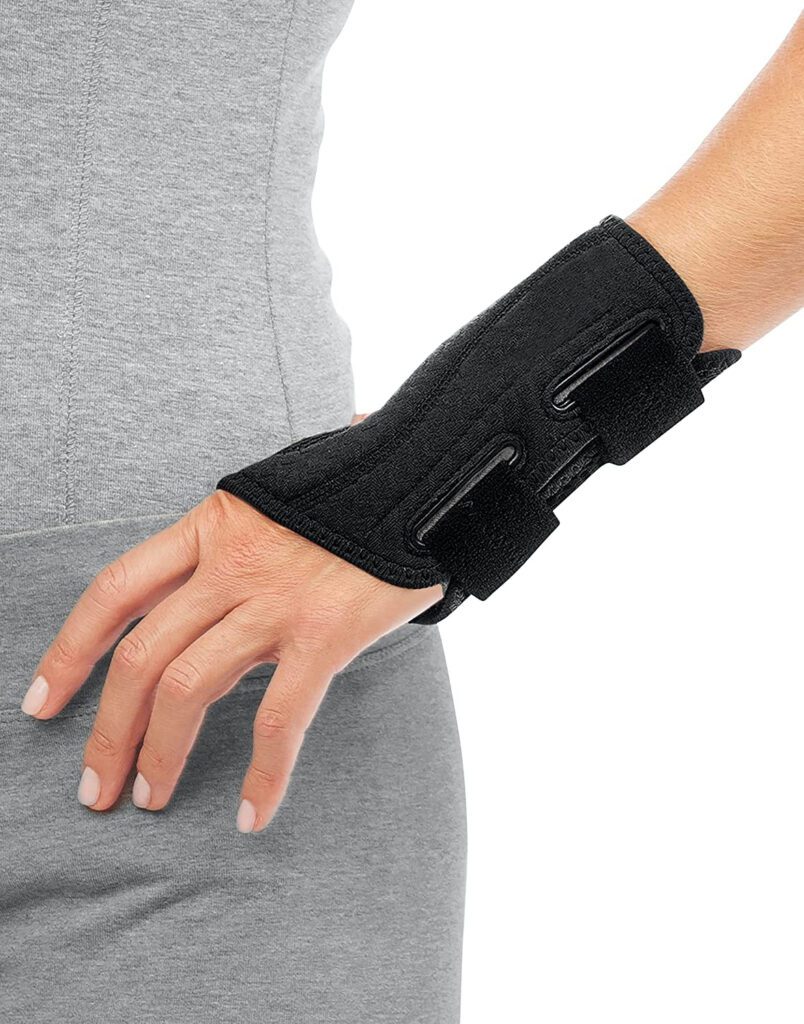
NuovaHealth™ Wrist Support Brace
Our next recommendation is a Wrist Support Brace, meticulously crafted to alleviate Carpal Tunnel Syndrome, Wrist Sprains, Tendonitis, Repetitive Strain Injuries (RSI), Wrist Fractures, Gout, and Arthritis.
This wrist brace features two removable metal splints, strategically placed to provide solid stabilization from both the top and bottom of your hand. By immobilizing your wrist in this manner, the brace ensures that tendons, ligaments, bones, and joints remain steady, thereby mitigating abnormal movements that could exacerbate your condition. This immobilization reduces pain and minimizes the risk of further injury during your recovery period. Additionally, the brace applies gentle compression that enhances blood circulation, accelerating the delivery of essential nutrients to the injured area, which helps in reducing inflammation, swelling, and discomfort effectively.
Equipped with fully adjustable straps, this brace allows you to customize the fit and adjust the level of support and compression to suit your specific needs. Crafted from soft, breathable material, it efficiently wicks away moisture, keeping your hand dry and comfortable throughout the day. The interior is cushioned with soft padding, which not only adds to your comfort but also absorbs shocks and vibrations, providing an extra layer of protection to your injured hand.
For optimal recovery, we suggest pairing this wrist brace with compression gloves. These gloves will enhance the compression and support provided by the brace, further promoting healing and reducing symptoms.
If you’re dealing with the discomfort of Carpal Tunnel Syndrome, this Wrist Support Brace could be an essential tool in your recovery toolkit, offering targeted support and relief.
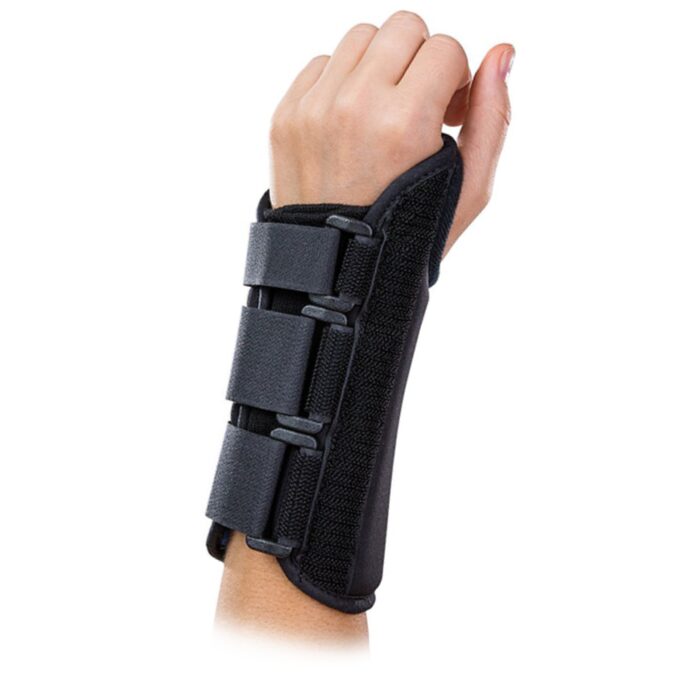
Carpal Tunnel Syndrome Wrist Splint Brace
This versatile brace is crafted to offer not just support, but also immobilization, compression, and protection for your hand and wrist. It’s a highly recommended tool by physiotherapists for treating various wrist and hand conditions, including fractures, sprains, strains, tendonitis, gout, and arthritis.
One of the standout features of this brace is its built-in metal splint. This essential component keeps your hand and wrist aligned, restricting any movement that could aggravate your condition. By maintaining this straightened position, the brace helps prevent further damage to your ligaments, tendons, and bones, making it especially beneficial for Carpal Tunnel Syndrome sufferers.
Beyond immobilization, this brace also excels in providing compression. This aspect is crucial as it helps to reduce swelling and inflammation, thereby alleviating pain. The enhanced blood circulation that comes from compression also accelerates the healing process, ensuring that your injured tissues recover more quickly.
The brace features multiple adjustable straps, allowing you to easily customize the fit, support, and compression level according to your needs. This ensures a secure fit that stays in place, giving you peace of mind as you go about your day. Additionally, the soft padded interior offers an extra layer of comfort and protection. It cushions your wrist against shocks and vibrations, further safeguarding against potential injuries and easing your recovery process.
In summary, whether you’re dealing with Carpal Tunnel Syndrome or other wrist-related issues, this Wrist Splint Brace is an excellent choice. It not only supports and protects but also significantly aids in pain relief and recovery, making it a valuable addition to your healing toolkit.
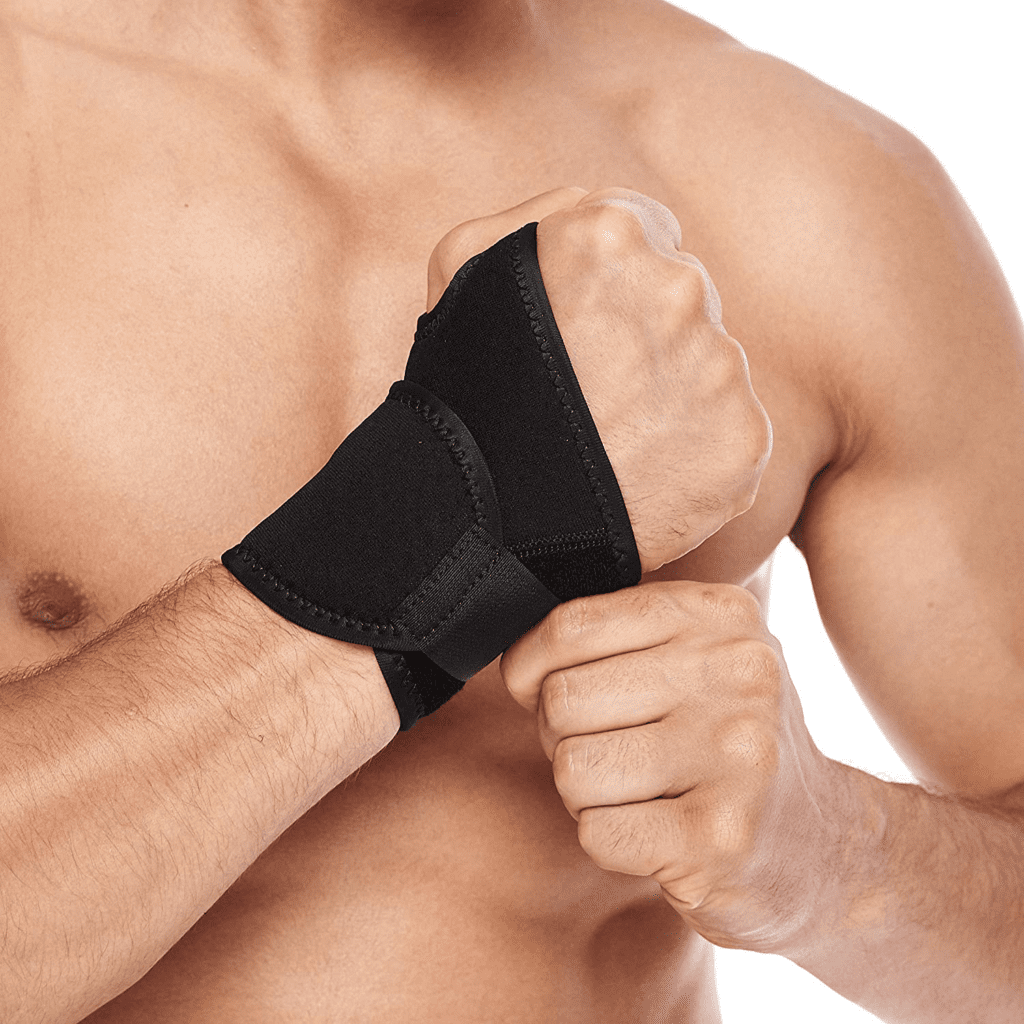
1X Pair of Hand & Wrist Support Wraps
Next on our list is the Pair of Hand & Wrist Support Wraps, a game-changer for anyone suffering from carpal tunnel syndrome. Imagine a product that not only aids in your recovery but also helps prevent future injuries. These wraps are precisely what you need.
Designed with input from leading physiotherapists globally, these wrist support wraps deliver effective treatment and prevention for various wrist and hand injuries. The wraps securely encircle your hands, held in place by a firm Velcro strap, ensuring they stay put without causing any uncomfortable rubbing against your skin.
The support they provide enhances your hand and wrist function, limiting movements that could exacerbate pain or result in further injury. By applying gentle yet firm compression, these wraps promote blood circulation, which is crucial for reducing inflammation and swelling. This increased blood flow accelerates the healing process, allowing you to recover more swiftly.
Many users find these wraps particularly beneficial during physical activities like weightlifting. They help alleviate the strain and pressure on your hands, thereby minimizing the risk of injury. The material used is not only lightweight and breathable but also features antibacterial and moisture-wicking properties. This ensures your hands remain dry, sweat-free, and comfortable, whether you’re exercising or wearing the wraps for extended periods.
In essence, these Hand & Wrist Support Wraps offer a practical, comfortable, and effective solution for managing carpal tunnel syndrome. Give them a try and experience the support and relief you deserve.
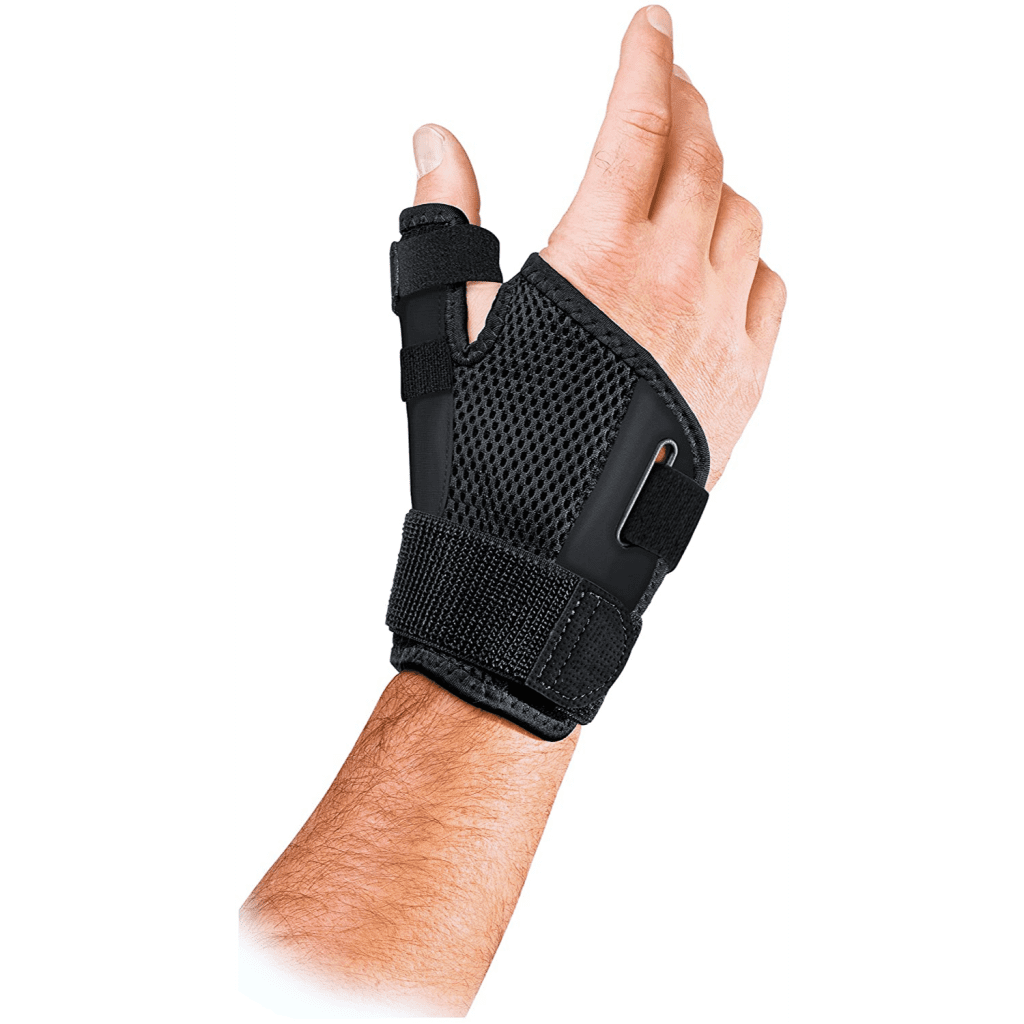
NuovaHealth™ Thumb & Wrist Stabilizer
Imagine a brace that feels almost weightless, yet provides the sturdy support your hand craves. Made from breathable materials, this stabilizer adjusts easily to fit your hand perfectly. By wearing it, you’ll find relief from the persistent symptoms of carpal tunnel syndrome, as it supports your wrist and thumb, reducing strain and promoting recovery.
The key feature of this stabilizer is its built-in metal thumb splint, which holds your thumb in an optimal position. Meanwhile, the adjustable wrist wrap secures your wrist, ensuring it stays aligned. Together, these features reduce pressure on your carpal tunnel, helping to alleviate pain and encourage healing.
Beyond support, this brace acts as a shield against harmful movements and shocks that could further damage your carpal tunnel. By minimizing excessive motion and vibrations, it protects your hand from additional injury and exacerbated pain. Plus, the compression provided by the brace not only soothes deep-seated aches but also enhances blood circulation. This dual action aids in reducing inflammation and swelling, common culprits in carpal tunnel syndrome.
Ideal for injury recovery, the NuovaHealth™ Thumb & Wrist Stabilizer promotes flexibility and strength in your healing hand. With its support, you’ll find it easier to regain mobility and function, making your journey to recovery smoother and more manageable.
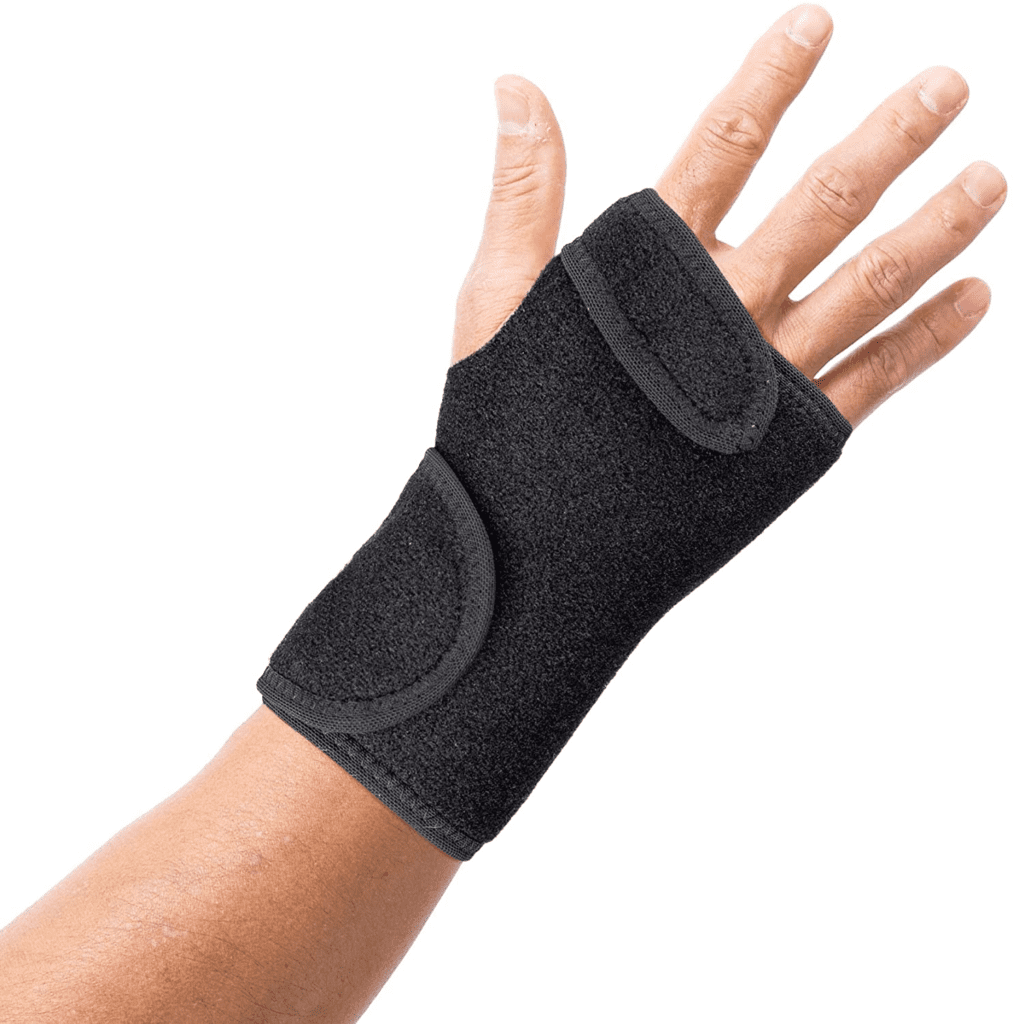
NuovaHealth™ Carpal Tunnel Brace
Next on our list is an affordable yet highly effective product for managing Carpal Tunnel Syndrome: the NuovaHealth™ Carpal Tunnel Brace. This clever device is designed with multiple features to alleviate your wrist pain and improve functionality. At its core, the curved metal splint is engineered to hold your wrist and hand in a neutral, comfortable position. By immobilizing these areas, it prevents unnecessary movement, reducing the chance of further damage and exacerbation of your symptoms.
The brace also offers soothing compression, which significantly boosts blood circulation to your hand and wrist. This enhanced circulation is crucial; it accelerates the healing process by delivering fresh, oxygen-rich blood to damaged cells. The gentle pressure also helps to alleviate deep-seated aches and diminish inflammation and swelling by effectively pushing out excess fluid often associated with Carpal Tunnel Syndrome.
Constructed from lightweight, breathable materials with a soft padded interior, this brace is designed for prolonged wear without discomfort. Its comfort level is so high that many physiotherapists recommend it for overnight use, ensuring you can enjoy a restful, pain-free sleep.
So, if you’re looking for a reliable, comfortable solution to your Carpal Tunnel pain, this NuovaHealth™ Carpal Tunnel Brace could be just what you need. It combines effective immobilization with beneficial compression to support your healing journey.
Discover Our Top Picks: Best Compression Gloves at NuovaHealth
At NuovaHealth, we are dedicated to offering you the finest solutions for hand and wrist support. Our top-tier compression gloves are designed with precision, using medical-grade materials to provide exceptional comfort and effectiveness. Whether you’re dealing with arthritis, carpal tunnel syndrome, or general hand fatigue, our gloves are engineered to alleviate pain and improve mobility. Plus, each pair comes with a full 30-day money-back guarantee, ensuring your satisfaction. Explore our top recommendations now and experience the benefits of superior hand and wrist support with NuovaHealth.
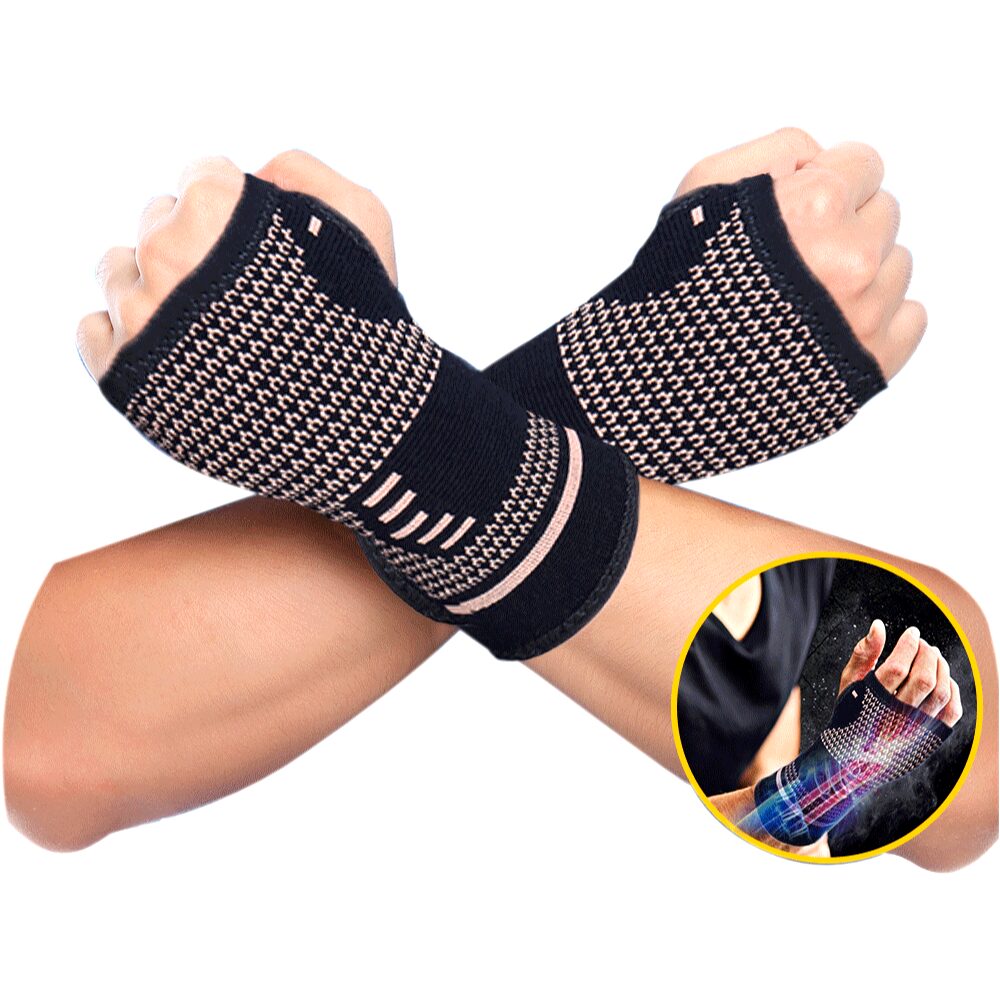
Copper Wrist & Hand Support Compression Sleeves
These sleeves are crafted to provide exceptional support and compression, making them a popular choice for individuals dealing with Carpal Tunnel Syndrome, Arthritis, Gout, Tendonitis, Fractures, and Repetitive Strain Injuries. The additional reinforcement from these sleeves helps alleviate aches and pains, reduce hand cramps and spasms, and prevent further injuries during the recovery phase.
These sleeves work by delivering targeted support that stabilizes your hand and wrist. This stabilization prevents excessive movement, reducing strain on your Carpal Tunnel and improving overall function. Additionally, the sleeves feature graduated compression, which deeply soothes aches and pains in your hands and wrists. This compression also enhances blood circulation, reducing swelling and inflammation, and accelerating the healing process by delivering oxygen-rich blood to damaged cells.
Our customers highly praise these wrist sleeves, which can be comfortably worn day or night. Made from high-quality, skin-friendly copper fabric, these sleeves offer long-lasting comfort. The copper-infused material boasts antibacterial and moisture-wicking properties, helping to eliminate bacteria, prevent odors, and minimize rubbing and chafing, keeping your hands dry and fresh.
Many users have found these sleeves invaluable for protecting their hands during daily activities, work, exercise, or sports. For optimal treatment of Carpal Tunnel Syndrome, we recommend pairing these sleeves with one of our braces listed below.
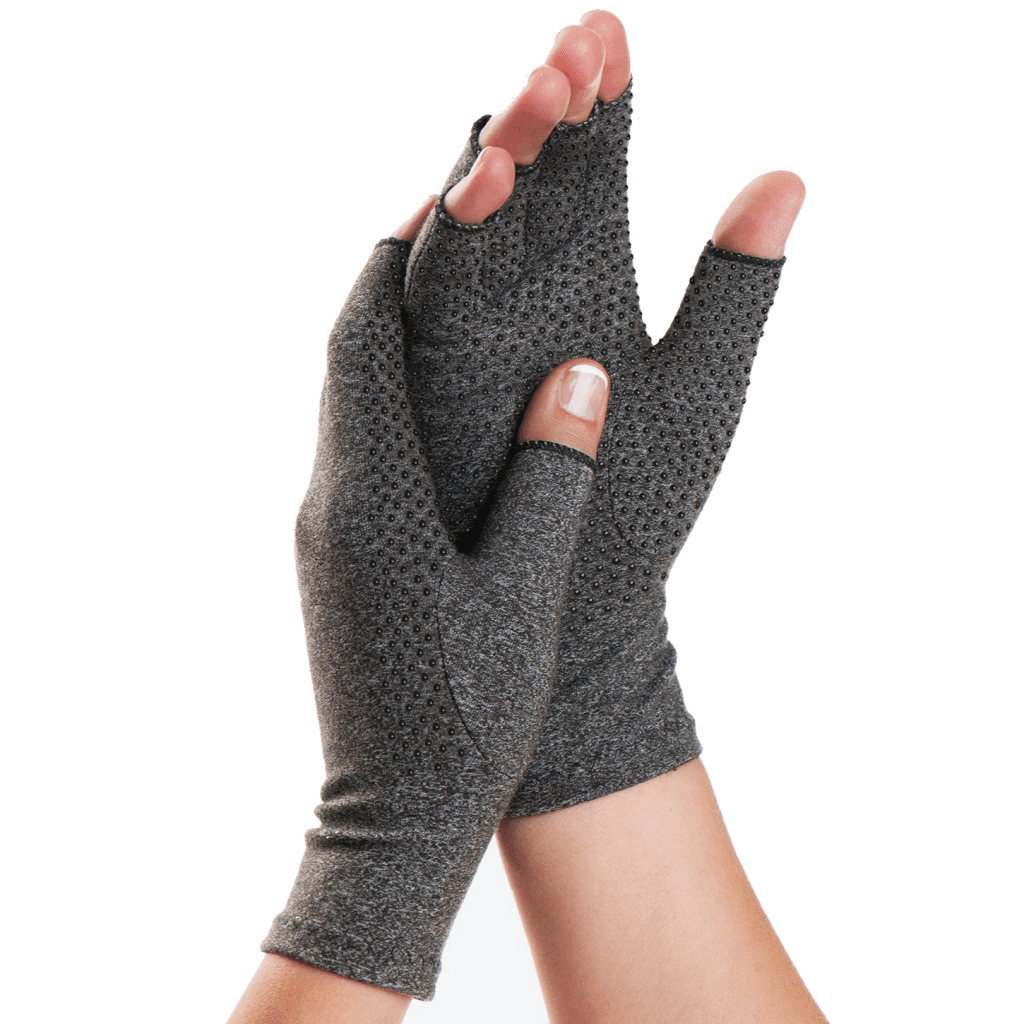
Compression Therapy Gloves with grips
These gloves aren’t just about easing your pain; they have the potential to enhance your recovery speed and boost the strength and flexibility of your hands and fingers.
These gloves work by applying consistent compression, which enhances the circulation of fresh, oxygen-rich, and nutrient-loaded blood to your hands and fingers. This improved blood flow promotes the healing of soft tissues. Additionally, the compression aids in draining excess fluid, reducing swelling and inflammation, and alleviating deep-seated aches and pains in your joints.
Crafted from soft, skin-friendly cotton, these gloves are designed for comfort. They’re breathable, wick moisture away, and have anti-odor properties, ensuring they won’t chafe or irritate, even when worn for extended periods. They’re perfect on their own or as liners under thicker thermal gloves during the cold winter months. The fingerless design means you can still use touchscreen devices without removing them, while the silicone grips on the palms and fingers enhance your hold on objects, making these gloves practical for almost any situation.
Our customers have found these gloves particularly useful during activities like typing, handwriting, sewing, and needlework. The gloves help prevent stiffness, fatigue, and muscle cramps by stimulating blood flow. They also support your hands and fingers, encouraging correct positioning and reducing the risk of excessive movement, shock, and pressure that could lead to further wear and tear or injury.
Why not give them a try? You might find they make a big difference in your daily comfort and long-term recovery.
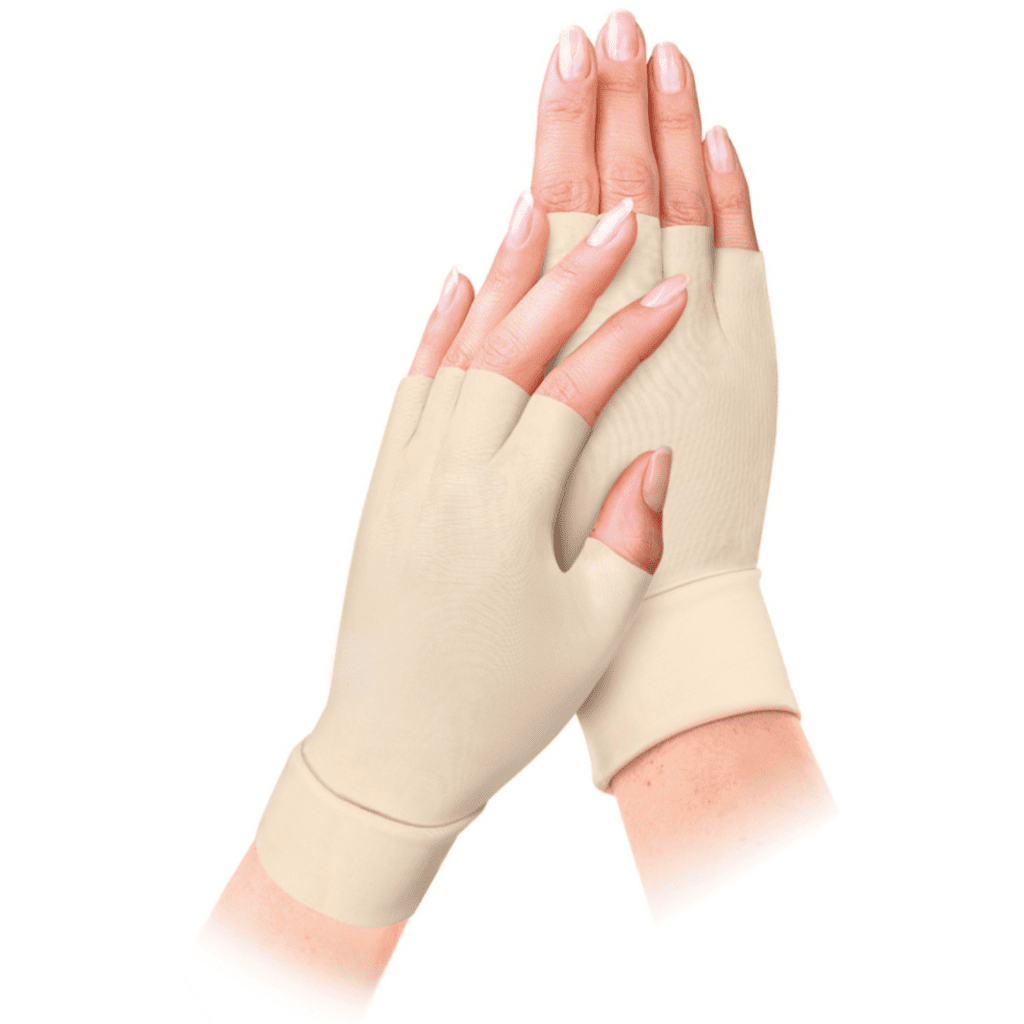
Compression Arthritis Gloves
Next on our list is a game-changer for those dealing with Carpal Tunnel Syndrome, Arthritis, or any hand-related injuries and conditions. These gloves provide precisely the support and compression your hands crave.
Imagine a glove that not only wraps your hands in comfort but also actively works to enhance your well-being. The compression these gloves offer boosts blood flow to your hands and fingers, accelerating the healing of damaged tissues. This targeted compression dives deep into your joints, offering swift and effective relief from aches and pains. Additionally, the improved circulation helps restore hand function and strength, reducing the risk of future injuries.
These gloves are more than just supportive; they enhance your hands’ mobility and flexibility, allowing you to navigate your daily activities with ease and less discomfort. Crafted from top-tier fabric, they are skin-friendly, durable, and lightweight. Their non-bulky design ensures breathability and comfort, making them ideal for extended wear without sacrificing ease of movement.
Slip these gloves on and feel the difference as you go about your day, knowing your hands are getting the support they need for a pain-free experience.
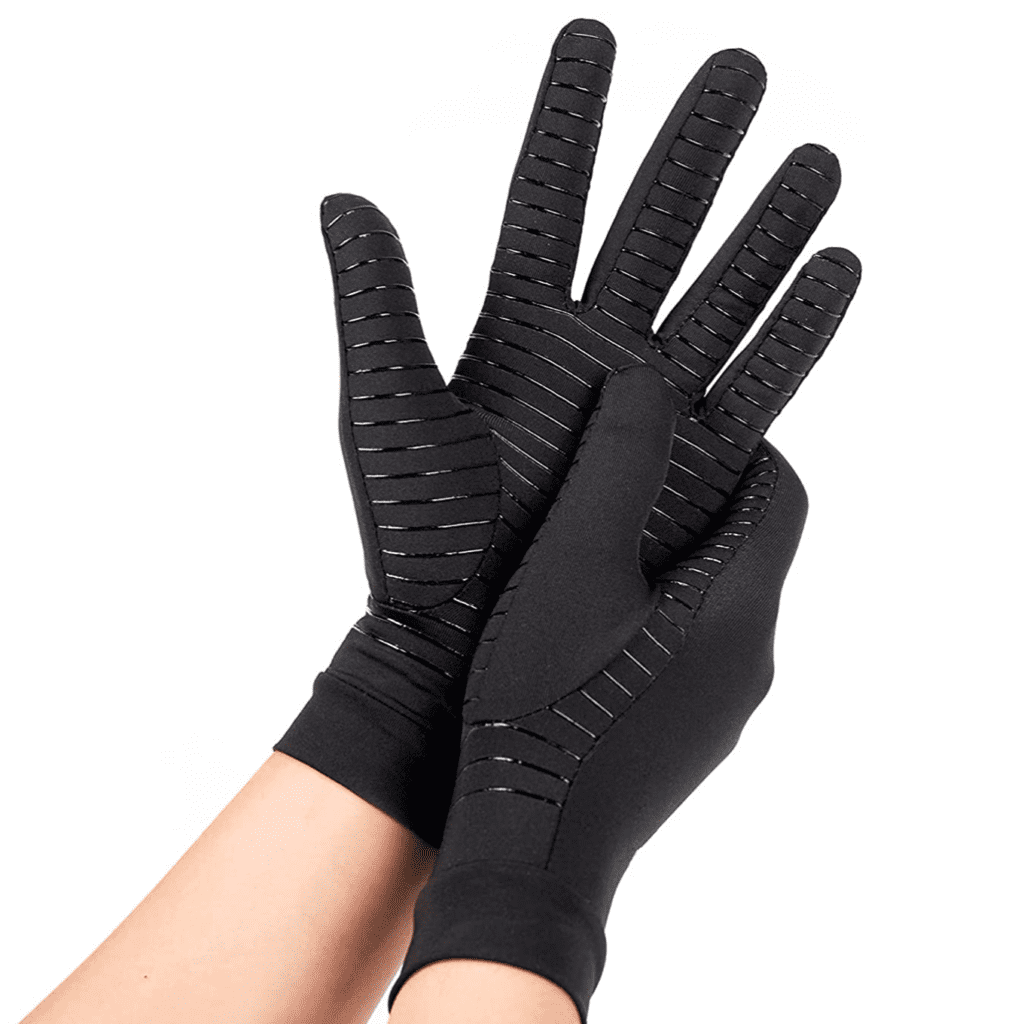
Full-Length Copper Infused Compression Gloves
Next on our list are these remarkable Full-Length Copper Compression Gloves. These gloves are designed for those dealing with Carpal Tunnel syndrome, Raynaud’s disease, Arthritis, Repetitive Strain injuries, swollen hands (Oedema), Gout, Neuropathy, and poor circulation.
When you slide these gloves on, they offer support by positioning your hands, fingers, and thumbs properly. This helps to reduce strain, pressure, and the risk of injury. The gentle compression stimulates blood flow, improving circulation to your hands. This enhanced blood flow alleviates pain, reduces inflammation, and can speed up recovery from Carpal Tunnel syndrome.
What makes these gloves stand out is their lightweight and breathable material, ensuring comfort throughout the day. Whether worn alone or under a pair of thermal gloves in colder weather, they provide the right balance of support and flexibility.
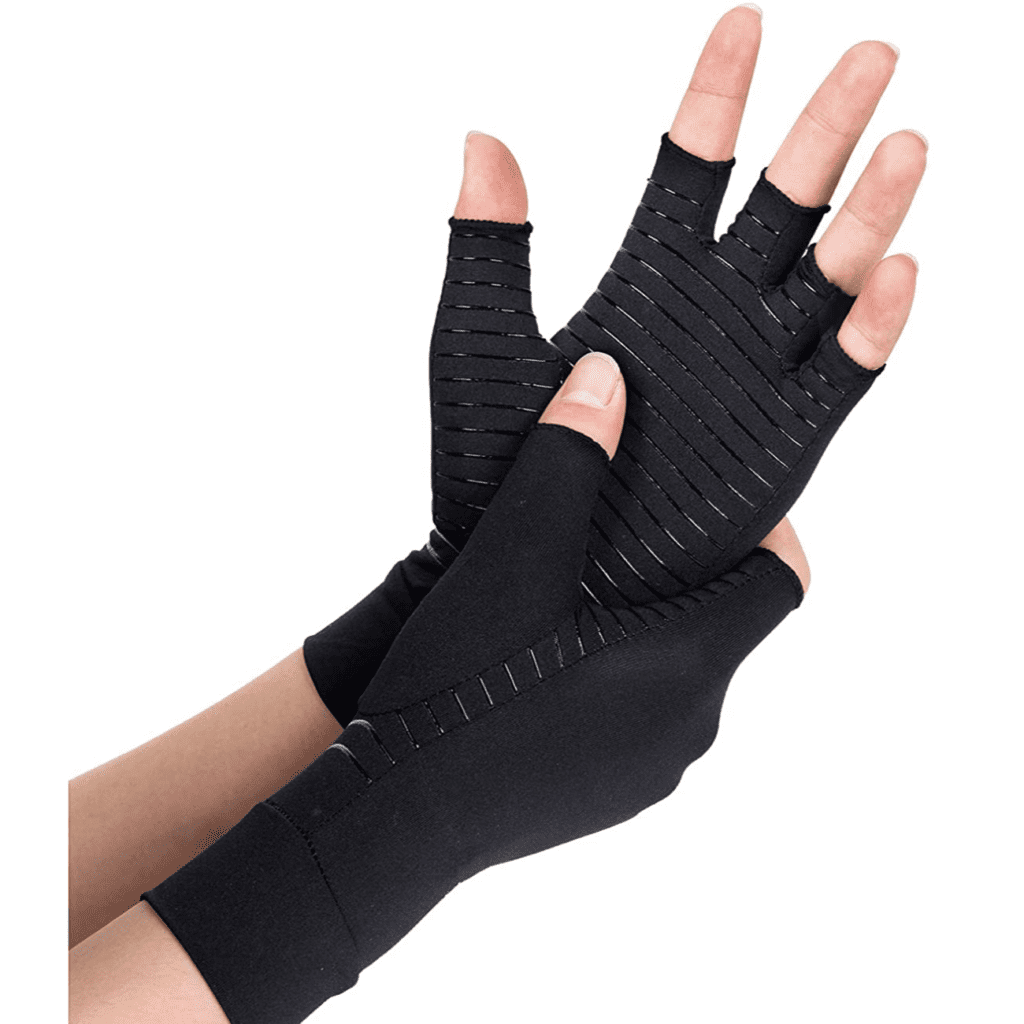
Fingerless Copper Infused Compression Gloves
These gloves offer exceptional support, keeping your tendons, ligaments, and joints in optimal alignment. By limiting movements that could exacerbate your condition, they provide a protective barrier, easing the strain on vulnerable areas.
What sets these gloves apart is their ability to enhance your hand function. They offer a blend of strength, mobility, and flexibility, crucial for a smoother recovery from carpal tunnel syndrome. Much like their full-length counterparts, these gloves deliver soothing compression. This compression is key to increasing blood circulation, accelerating the natural healing process, and alleviating discomfort, inflammation, and swelling.
Crafted from a blend of nylon fabric infused with copper, these gloves do more than just support. The copper infusion brings antibacterial properties, keeping your hands free from harmful microbes while the moisture-wicking fabric ensures they stay dry and comfortable throughout the day. This blend is perfect for preventing the buildup of bacteria and potential infections.
Additionally, the gloves feature specially designed anti-slip grips on the palms and fingers. These grips enhance your ability to handle objects securely, reducing the risk of items slipping from your grasp. Whether you’re carrying groceries or typing on a keyboard, these gloves ensure you have a firm hold.
In essence, our Fingerless Copper-Infused Gloves combine comfort, support, and functionality, making them an excellent choice for anyone looking to manage and recover from carpal tunnel syndrome.
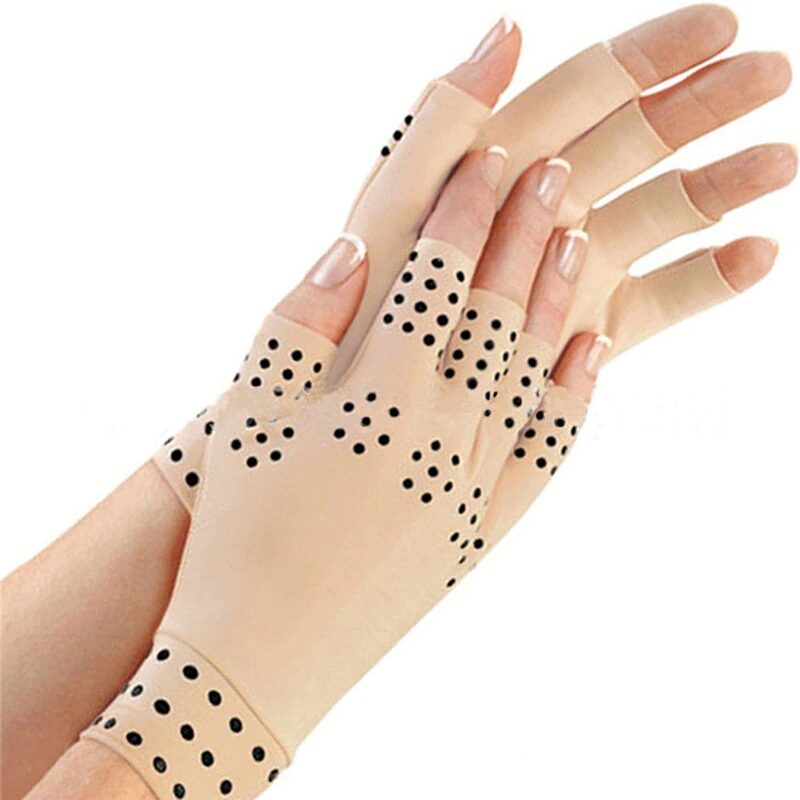
Magnetic therapy Compression Gloves
The next item you’ll want to consider is a pair of Magnetic Therapy Compression Gloves. These gloves come with strategically placed magnets designed to deliver soothing magnetic therapy that targets those deep-seated aches in your joints.
Beyond magnetic therapy, these gloves excel in providing robust support and compression. This support is essential for preventing additional damage by optimizing hand and finger function and alleviating strain. This way, you’re not just managing symptoms but also fostering a full, proper recovery from Carpal Tunnel syndrome. The gentle compression facilitates quicker healing while easing any lingering pain or discomfort.
But that’s not all—these gloves aren’t limited to Carpal Tunnel syndrome. They are also effective for managing various hand and wrist conditions like Arthritis, Gout, Oedema, Raynaud’s Disease, and Repetitive Strain Injuries. They’re not just a treatment; they’re a smart choice for ongoing hand and wrist health.
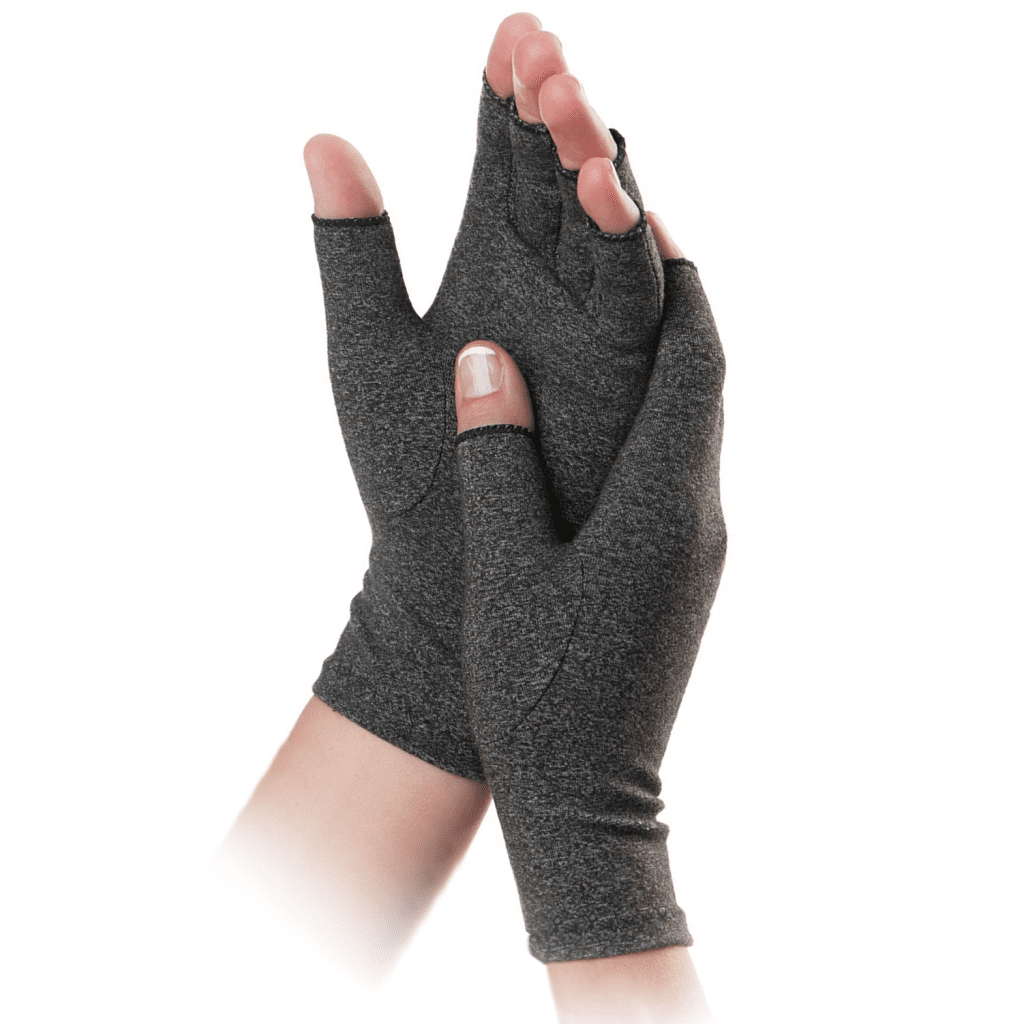
Therapeutic Compression Gloves
Next on our list are these remarkable therapeutic compression gloves. Imagine slipping your hands into something soft, lightweight, and breathable yet incredibly supportive. Especially if you’re dealing with Carpal Tunnel Syndrome, these gloves can be a game-changer. The gentle compression they provide is designed to alleviate pain and enhance blood circulation, which can accelerate the healing of damaged tissues.
What makes these gloves exceptional is their ability to support your hands and fingers effectively. By promoting proper biomechanics, they help limit excessive movements that could potentially cause injury. Whether you’re typing away on a computer, sewing, or engaged in other intricate tasks, these gloves are your go-to solution. They’re built to offer the right kind of support, ensuring that your hands move correctly and comfortably.
In addition to structural support, the gloves also work wonders by enhancing mobility. This, in turn, minimizes muscle cramps and alleviates stress on key tendons and ligaments. The compression element helps deliver fresh, oxygenated blood to your hands, fighting off fatigue and reducing inflammation. Experience the joy of working longer and more comfortably, without the constant strain on your hands.
Disclaimer:
The information provided in this article is intended for general informational purposes only and should not be used as a substitute for professional medical advice, diagnosis, or treatment. While we aim to offer accurate and up-to-date guidance on carpal tunnel syndrome, including recommended products available from NuovaHealth, it is essential to consult with a healthcare provider for a proper diagnosis and personalized medical advice.
Carpal tunnel syndrome can present with symptoms that mimic other medical conditions, making self-diagnosis risky and potentially harmful. Only a qualified healthcare professional can accurately diagnose your condition through proper medical evaluation, which may include physical examinations, nerve conduction studies, or imaging tests.
For example, symptoms like numbness, tingling, and weakness in the hand might be caused by conditions other than carpal tunnel syndrome, such as diabetic neuropathy (nerve damage due to diabetes) or cervical radiculopathy (nerve pain originating from the neck). Misinterpreting these symptoms and self-treating based on incorrect assumptions could lead to ineffective treatment and potentially worsen your health.
Please remember, the products and recommendations mentioned in this article are not intended to replace professional medical treatment. They are suggested to complement a treatment plan prescribed by your healthcare provider. Effectiveness of these products can vary from person to person, and what works for one individual may not necessarily work for another.
Therefore, we strongly urge you to consult with your doctor or a qualified healthcare professional before starting any new treatment for carpal tunnel syndrome. Your health and well-being are of utmost importance, and professional guidance ensures that you receive the most appropriate and effective care tailored to your specific condition.
Thank you for understanding, and we hope this article helps in guiding you towards better management and relief from carpal tunnel syndrome.
Stay informed, stay healthy, and always seek professional advice.
Sincerely,
The NuovaHealth Team